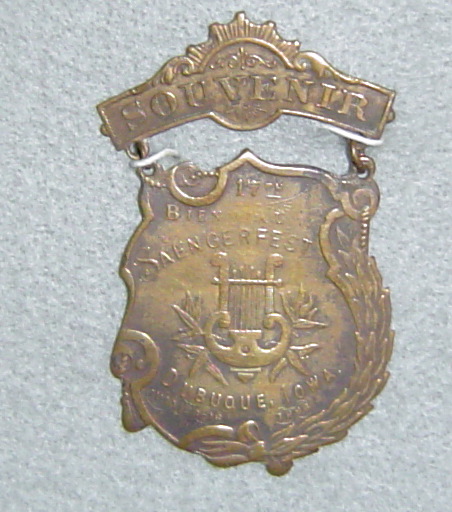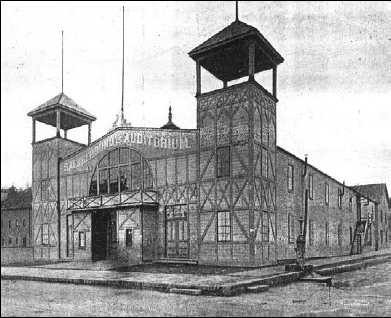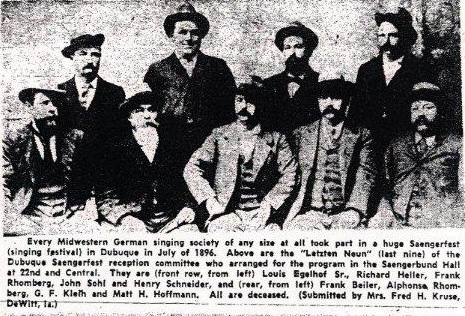Encyclopedia Dubuque
"Encyclopedia Dubuque is the online authority for all things Dubuque, written by the people who know the city best.”
Marshall Cohen—researcher and producer, CNN
Affiliated with the Local History Network of the State Historical Society of Iowa, and the Iowa Museum Association.
DUBUQUE SAENGERBUND: Difference between revisions
No edit summary |
No edit summary |
||
| Line 1: | Line 1: | ||
[[Image:medal.jpg|left|thumb|150px|A souvenir of a Saengerbund festival. Photo Courtesy: Bob Reding]] | [[Image:medal.jpg|left|thumb|150px|A souvenir of a Saengerbund festival. Photo Courtesy: Bob Reding]] | ||
DUBUQUE SAENGERBUND | DUBUQUE SAENGERBUND. The Saengerbund was formed through the merger of the Dubuque and Helvetia Maennechors. The former group had been formed on August 8, 1868, while the latter developed during the spring of 1870. The organization focused on vocal excellence. An initiation fee of one dollar was charged with annual dues of three dollars. F. A. Hopple, the director, led practice sessions weekly on Wednesday evenings at [[DUBUQUE CITY HALL]]. | ||
In 1873 Dubuque was the host of the "greatest" of the Saengerfests. Saengerbunds from all over America attended. Businesses in town contributed generously hoping to win food prizes. The local group was large enough at the time to sponsor a soccer team. Since the closest fields were located in Davenport, interest soon declined and the team disbanded. (1) | |||
[[Image:saeaud.png|left|thumb|250px| | [[Image:saeaud.png|left|thumb|250px| | ||
The Saengerbund Auditorium stood at the southeast corner of Kaufmann and Central. Photo courtesy: James E. Jacobsen]]The Saengerbund Auditorium was constructed in 1896. This massive frame | The Saengerbund Auditorium stood at the southeast corner of Kaufmann and Central. Photo courtesy: James E. Jacobsen]]The Saengerbund Auditorium ("Germania Building) was constructed in 1896. This massive frame building costing $6,000 housed the “German Day” events of October 16, 1902, described as “the grandest spectacle ever witnessed in Dubuque.” The regional event featured a 13-block long parade. The hall was demolished soon after this event: the operating cost exceeded the resources of the Saengerbund organization. | ||
The singing society continued and prospered. At its height, the organization had an estimated seventy-five Dubuque residents, according to Ferdinand Schnebeck who served as president from 1940 through 1954. [[WORLD WAR II]] caused the group to go inactive, and it was difficult to reorganize. (2) | |||
[[Image:saebridgefair.png|right|thumb|550px|]] | [[Image:saebridgefair.png|right|thumb|550px|]] | ||
[[Image:German singers.jpg|left|thumb|450px|Photo courtesy: Telegraph Herald, June 21, 1957 and Diane Harris]] | [[Image:German singers.jpg|left|thumb|450px|Photo courtesy: Telegraph Herald, June 21, 1957 and Diane Harris]] | ||
| Line 10: | Line 14: | ||
Source: | Source: | ||
1. Dahlinger, Mark. "Singing Society Still Alive," ''Telegraph Herald'', August 1, 1954, p. 7 | |||
2. Ibid. | |||
Jacobsen, James E. ''The Architectural and Historical Resources of Dubuque, Iowa, 1837-1955'', p. 7 | Jacobsen, James E. ''The Architectural and Historical Resources of Dubuque, Iowa, 1837-1955'', p. 7 | ||
[[Category: Organizations]] | [[Category: Organizations]] | ||
[[Category: Musician]] | |||
Revision as of 01:58, 26 March 2015
DUBUQUE SAENGERBUND. The Saengerbund was formed through the merger of the Dubuque and Helvetia Maennechors. The former group had been formed on August 8, 1868, while the latter developed during the spring of 1870. The organization focused on vocal excellence. An initiation fee of one dollar was charged with annual dues of three dollars. F. A. Hopple, the director, led practice sessions weekly on Wednesday evenings at DUBUQUE CITY HALL.
In 1873 Dubuque was the host of the "greatest" of the Saengerfests. Saengerbunds from all over America attended. Businesses in town contributed generously hoping to win food prizes. The local group was large enough at the time to sponsor a soccer team. Since the closest fields were located in Davenport, interest soon declined and the team disbanded. (1)
The Saengerbund Auditorium ("Germania Building) was constructed in 1896. This massive frame building costing $6,000 housed the “German Day” events of October 16, 1902, described as “the grandest spectacle ever witnessed in Dubuque.” The regional event featured a 13-block long parade. The hall was demolished soon after this event: the operating cost exceeded the resources of the Saengerbund organization.
The singing society continued and prospered. At its height, the organization had an estimated seventy-five Dubuque residents, according to Ferdinand Schnebeck who served as president from 1940 through 1954. WORLD WAR II caused the group to go inactive, and it was difficult to reorganize. (2)
___
Source:
1. Dahlinger, Mark. "Singing Society Still Alive," Telegraph Herald, August 1, 1954, p. 7
2. Ibid.
Jacobsen, James E. The Architectural and Historical Resources of Dubuque, Iowa, 1837-1955, p. 7





